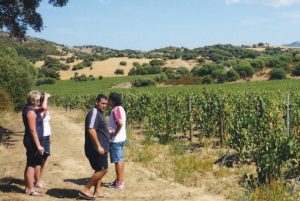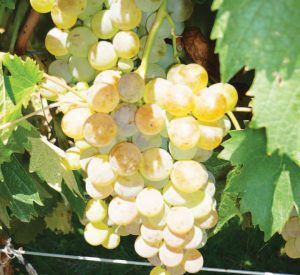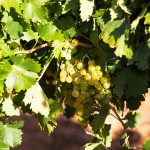By Kim Chalmers, Chalmers Wines, PO Box 2263, Mildura, Victoria, 3502. Email: [email protected]
First published in the November/December 2011 issue of the Wine & Viticulture Journal
Kim Chalmers, of Australian Vermentino-pioneering Chalmers Wines, shares a snippet of her recent experience in exploring the variety in its homeland of Sardinia, in Italy, and summarises her family’s work in propagating, growing and making wine from the variety.

If the number of Vermentino wine entries in the Australian Alternative Varieties Wine Show (AAVWS) are anything to go by, Australia is seeing a definite trend emerge. The 2011 AAVWS has seen 34 varietal Vermentinos entered in the class, up from 15 in 2010. It’s not a bad rate of growth, given the first home-grown Vermentino wines entered the Australian market as recently as 2004, when my family’s Murray Darling Collection Vermentino, labelled A Murray Cod Called Bruce, and two other wines, were made from our original Euston planting and released that year.

Vermentino in Sardinia
Vermentino is an Italian white variety that is famous for being produced on the island of Sardinia, which boasts Italy’s only area of Denominazione di Origine Controllata e Garantita (DOCG, translating to controlled designation of origin guaranteed) status for the variety in Gallura, on the northern tip of the island. Gallura is a mountainous region stretching south and inland from the coast and reaching elevation of up to 1362 metres. Interestingly, this region is quite cold in winter, even receiving snow at higher elevation sites. The other regions in Sardinia that grow Vermentino are lower in elevation and sometimes close to the sea. The whole island is prone to windy conditions, with the average wind speed being 16km/hr daily. Known as the mistral wind, it usually blows from the north and north-west. Although the summers in Sardinia can be quite arid with little or no rainfall from June to August, vineyards there are traditionally unirrigated. Nowadays, almost every vineyard is irrigated, which growers will say is only for emergencies “when the vines are dying”.
In August this year, I visited Sardinia as I wanted to see how the vineyards coped with the mid-summer temperatures while carrying a full crop load. In the regions of Alghero and Gallura, in mid-August, growers were gearing up to begin vintage the following week – a very early season. So, I was able to see mature Vermentino fruit on the vine in daily maximum temperatures of around 30-35°C. The locals thought it was very hot (average summer temperatures for Sardinia are normally 28-30°C) but the vines seemed to be coping well with no emergency irrigation required – as yet, they told me. Interestingly, none of the vignerons could say what Sardinia’s average rainfall was – or how much had fallen that season – but their summers are usually dry, with most rain falling in autumn and spring. The average annual rainfall is 427mm, although, they have been in a drought pattern for some years now, so one would assume they have had considerably less rainfall.
The vineyards I saw were varied in their setup and included everything from two- and three-wire vertical mechanised vineyards – like you see in commercial plantings in inland Australia – to super
high-density, vertically-trained vines yielding only 3.5 tonnes per hectare. Many of the Vermentino vineyards are less than 20 years old and most of the growers I spoke to were of the opinion that vineyards were best redeveloped after about 20 years to keep productivity up.
A cooperative winery I visited in the Alghero region, Cantina Santa Maria La Palma, worked with more than 300 growers across 700 hectares of vineyard – predominantly planted to Vermentino. It makes two million bottles of Vermentino a year, most of which is consumed in the domestic market. Representatives from this winery generously spent half a day with me, showing the vineyards and the region, before giving a tour of the winery and hosting tastings with the winemaker.
For me, one of the most interesting things about the cooperative at Santa Maria La Palma is that they also do extensive self-funded research into diverse varieties and clones. They specialise in traditional Sardinian varieties (Vermentino and Cannonau, as well as the less common Monica and Cagnulari). However, in their experimental block, they have varieties from all over Italy and other parts of the world where they are working with different clones, rootstock combinations and management techniques in an effort to improve diversity and quality in their wine production. It’s a considerable commitment in a country that has strict regulations about what can be planted where, and in a region that is not strong economically. It was inspiring to see this research project. Perhaps most exciting of all was to see that Santa Maria La Palma is working with Vermentino VCR1, which is the clone we brought into Australia through Chalmers Nurseries and have established in two of Chalmers Wines’ new blocks.
Vermentino at Chalmers Wines
Vermentino was one of the selections brought in by Chalmers Nurseries in the late 1990s, a clone from Vivai Cooperativi Rauscedo (www.vivairauscedo.com) called VCR1. We also sourced a selection of Rolle, clone H62, which was existing in Australia, having already been brought in by the CSIRO in 1974. Mother blocks of both of these clones of Vermentino were established in 2001 at our original Euston vineyard, in south-western New South Wales. The VCR1 selection took a while to multiply and establish, as we were only able to bring in one vine. However, the H62 selection was planted in a larger block from the outset, as we had access to a greater source of planting material.
We had Vermentino established on three different trellis types at the Euston site, all on flat country at about 54m above sea level. The two hectares of H62 (on SO4 rootstock) was setup on a fresh fruit style of diamond trellis, running east-west at 1837 vines per hectare (1.65m x 3.3m). This configuration was not deliberate, as we replaced a patch of fresh fruit with this planting and intended to change the trellis. However, we had good results from a somewhat unconventional trellising system for winegrapes.
We hand harvest all the fruit for our own label, so the lack of access for mechanised processes due to the diamond trellis was not an issue.
We also found that the format of the canopy on this trellis worked well to provide dappled sunlight across the entire crop to give even ripening (uneven ripening is sometimes raised as an issue with Vermentino). The vine structures were large with this system, as Vermentino thrives in the warm conditions and sandy calcareous soils of the Murray Darling. However, at this density and with this trellis, we had no problem growing excellent quality fruit at 25t/ha.
The 2001 Vermentino VCR1 planting was just 0.1 hectare, part of the mother block of all the imports, and was planted at 2667 vines per hectare in north-south orientation on a single bi-lateral cordon VSP system, with three sets of foliage wires. This method was selected in order to grow the best canes for propagation material. It also allowed the fruit exposure to the sun, which is required to give Vermentino its golden blush – an indicator of maturity. In hindsight, we probably wouldn’t develop in north-south orientation again, as the western aspect of the row was blasted in extreme summer periods, creating slightly uneven ripening from one side of the row to the other. In the harshest cases, it caused some sunburn. However, the VSP method definitely showed positive results when grown at a lower yield than the other systems, and has been applied in our Heathcote vineyard, which was planted in 2008. This system does increase labour in the vineyard due to the lifting of the foliage wires during the growing season, so, it is not ideal for lower value products.
The third Vermentino block at the Euston site, established in 2004, was also VCR1 clone planted on its own-roots at 3300 vines per hectare (1m x 3.3m) on a two-wire vertical with a foliage catch-wire, at east-west orientation.
We found this system was great for similar reasons to the diamond trellis: large, open canopies, with evenly lit fruit and balanced crop load, ability to grow quality fruit at higher yields and ease of management because of simple tractor access.
In recent years, we have established two new Vermentino vineyards at our new properties, having sold the Euston site in 2008. Chalmers’ Heathcote vineyard was planted in 2008 to 13 different varieties, mostly Italian, including three hectares of Vermentino VCR1 (on 110 Richter, as it is good stock for dry growing). The soil on this block is of ancient Cambrian origin, comprised of deep red loam, rich in iron oxide, and slightly alkaline (about pH8), which is well-suited to growing many Italian varieties. It is planted at 4555 vines per hectare, in east-west orientation, at an average of 190m elevation on the east-facing slope of the hill, on arched-rod pruned VSP with three sets of foliage wires. We believe this setup is ideal, as it allows exposure of the fruit but no harsh afternoon sun because of the orientation. It provides good airflow around the fruit and good air drainage down the slope for disease and frost rotection.
Vermentino is a relatively hardy variety with thick skins and loose bunches, but this vineyard design optimises that, particularly in the wetter climate of Heathcote than we had been used to in the Murray Darling. We intend to crop Vermentino in this vineyard at 10-15t/ha, which is considered very high for the region.
Chalmers’ Merbein vineyard was planted in 2010 and includes two hectares of Vermentino VCR1 on 140 Ruggeri at 2222 vines per hectare, running east-west on a light slope about 60m above sea level. The soil of this vineyard is red sandy loam with some clay content at the bottom of the hill. The block
is planted on a two-wire VSP, with a foliage catch-wire. This planting is contracted to a major winery, so, we have used a more commercial style setup to allow for mechanisation, but will continue to and spur-prune, as we did on the Euston plantings. We intend to grow the crops at 20-25t/ha here.
All these vineyards have been established to drip irrigation. On average at Euston, we used 3.5-4.5ML/ha per year to produce 20-25t/ha of fruit and would have never applied more than 5ML/ha in a season. We expect Merbein to be similar, in the 3.5-4.5ML range. In 2011 – our first vintage from Heathcote – we used no irrigation due to high rainfall, but we expect to not use more than 2ML/ha in a season there, with an average rainfall of 500mm and a soil structure with high readily-available water.
Our first Vermentino wines were made in 2004 – one at Kooyong, by Sandro Mosele, under our Murray Darling Collection label, and the other at Boyntons, under our now defunct Paiko label. Working with the Kooyong facility, we have continued producing Vermentino under the Chalmers label, with our current vintage of 2010 being our last from the Euston site. The newly-bottled 2011 wine is our eighth vintage of Vermentino and our first from Heathcote.
We like to harvest our Vermentino as soon as possible after physical ripeness is achieved. We look for the classic golden blush on the berries, mature seeds and skins with no green flavours, and lignified stems on the bunches. Usually, we will pick at between 10-11.5 Baumé, eventuating in a finished wine of 11.5-12.5% v/v. At Euston, the average harvest date was mid-February and, in 2011 in Heathcote, the Vermentino was picked in mid-March. Given the wet season, this is probably a little later than what we would normally expect for our planting there, but time will tell the results. The analysis in 2010 from Euston was 10.2Be, pH3.8, TA 5 (harvest date 10 February); 2011 from
Heathcote was 11.2Be, pH3.42, TA 6.4 (harvest date 16 March).
In our experience, the fruit spectrum of VCR1 is more grapefruit to white nectarine character, whereas we found more yellow peach in the wines from the H62 clone. Overall, Vermentino has been a pleasure to grow and not too problematic in the winery. We go for a savoury, textured style of wine using wild fermentation on solids at 16°C in stainless steel tanks.
Then, it is bottled after about six months and released at about nine months of age. Among the Chalmers range of wines, the Vermentino has definitely been the most popular and is made in the largest volumes within our brand. It is the largest planting by area in our Heathcote vineyard, and a wine we think suits the Australian marketplace and lifestyle fantastically well.
In all, I think the resilience and versatility of the variety lends itself to Australian viticulture. Perhaps more importantly, the diversity of wine styles achievable and the ability to produce wines of finesse and complexity at lower alcohol in hot dry conditions makes Vermentino a key variety for the future of our industry.
Vermentino

By Peter Dry, Emeritus Fellow, The Australian Wine Research Institute
Background
Vermentino (ver-men-TEE-no) is widely distributed in France and Italy. Consequently, it has many synonyms, including Vermentinu (Corsica), Rolle (Provence), Pigato (Liguria) and Favorita (Piedmont). Globally there were 8617 ha in 2010 (up 48% from 2000), 60% in Italy and 40% in France. Vermentino makes up 36% of the planted area of Liguria, 17% of Sardinia, 11% of Corsica and 10% of Provence. In Sardinia it is most prized in the northern Gallura region where it is used for the only DOCG wine of the island. Interest in this variety is increasing, both in its regions of origin and elsewhere—for example, relatively new plantings can be found in Languedoc and Roussillon in southern France and in coastal Tuscany. In Australia there are currently at least 92 wine producers, mainly in warm to hot climatic regions in SA, NSW, Vic. and WA. In 2015, there were 121 ha in Australia (49 ha in SA).
Viticulture
Vermentino bursts mid-season and ripens mid-season to late. It is productive with medium to large loose bunches. The medium to large berries have moderately thick skin and are green/yellow to yellow/amber depending on the degree of bunch exposure. Growth habit is relatively erect. Both spur and cane pruning are used in Australia. In Sardinia, it is trained to unilateral cordons with 4 to 5, 2-bud spurs. In Piedmont, cane pruning is normally used on a VSP system. Vermentino is reported to have good drought tolerance in Europe but of course it is mainly grafted there to phylloxera-resistant rootstocks. Basal leaf loss and moderately stressed vines can be observed in Sardinia with limited irrigation. It does appear to be quite heat tolerant in Australia. Three clones are currently available in Australia. Italian reports note sensitivity to downy mildew, with some tolerance of powdery mildew and Australian experience suggests low disease susceptibility. In the Riverland, Yalumba personnel observed less bunch rot on Vermentino than Chardonnay during the wet 2011 vintage.
Wine
Vermentino is able to retain acid well in a hot climate so long as it is not over-cropped. Its wines have been described as light, crisp, racy and delicately-flavoured with lemony acidity, minerality and texture. Other flavour descriptors include pink grapefruit, mandarin, lemon rind and passionfruit. There are mixed reports of desirable berry exposure, with excessive exposure undesirable for some wine styles, but some exposure required for optimal flavour development. In Liguria it may be left to hang on the vine until there is some shrivel, whereas Australian producers generally prefer to pick early to avoid overripe characters and produce fresh, more delicate styles.














